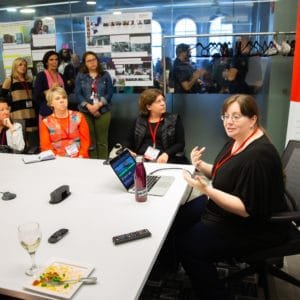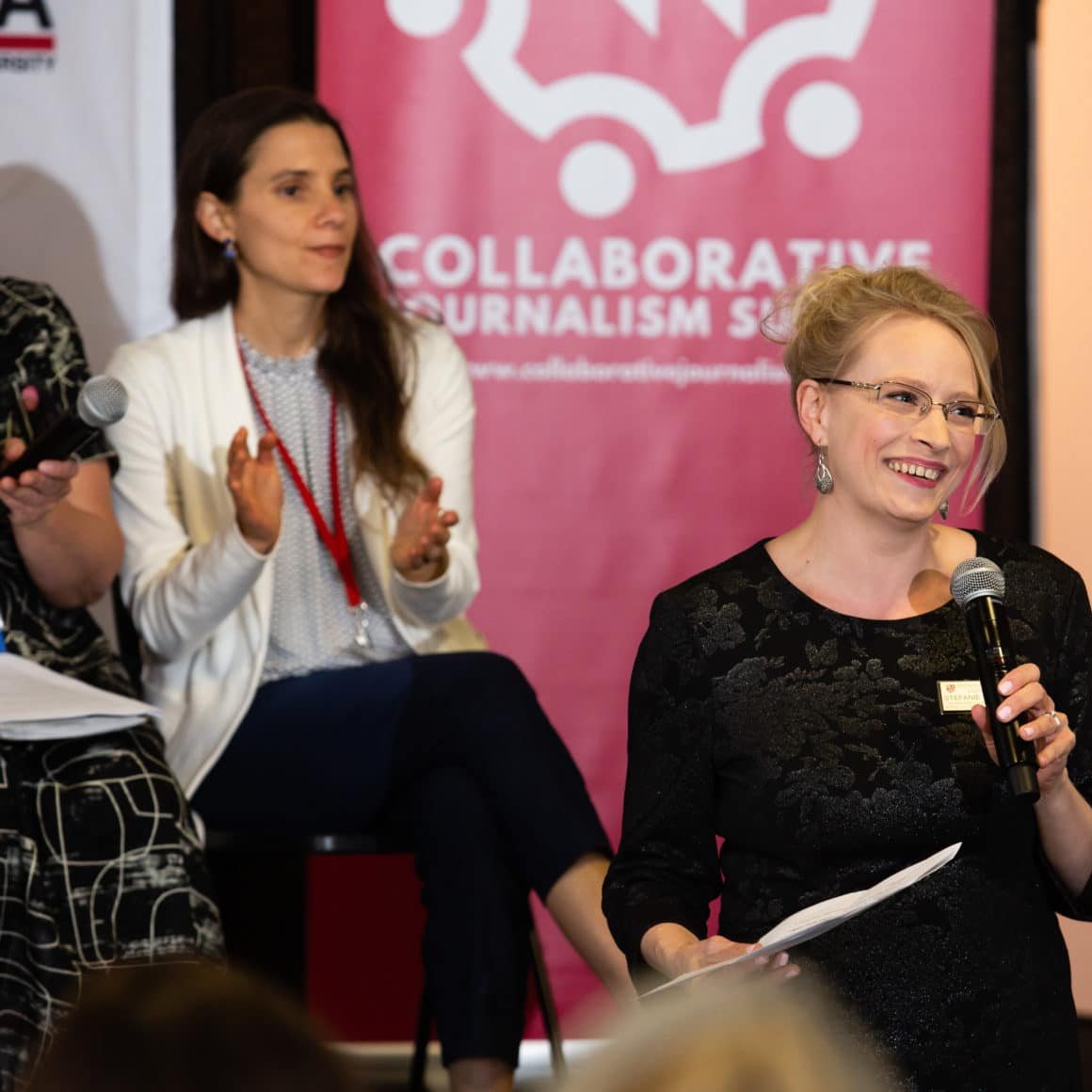PHILADELPHIA, PA – The conference room that was empty, quiet and still just minutes ago is now crammed with more than a hundred people. The space is filled with buzzing conversation, laughter, and the sound of clinking glasses. The smell of warm pastries and grilled chicken fills the air. Humidity. But mostly a great time.
One of the attendees separates herself from the crowd and sneaks into a smaller conference room in search for a plug to charge her phone. This room is much quieter, with only Heather Bryant speaking and demonstrating Project Facet, a service she founded to help manage and coordinate the work of collaboration.
Within seconds, the attendee seems to forget why she came to the room in the first place, and instead starts paying attention to Bryant, curiously taking in every word, listening to the possibilities that the service could mediate in the future.
This summit is all about collaboration, after all.

Heather Bryant explains how newsrooms can use Project Facet to manage their collaborative reporting projects. Photo by Leslie Barbaro.
The idea of collaboration within the journalism field is not completely new to me – I’d heard about the Reentry Project and Broke in Philly. Nevertheless, I’d been skeptical about the logistics of those projects because, let’s be honest, a collaboration among competing outlets sounds somewhat utopian. Based on my experience (and all the journalism-themed movies I’ve ever watched), newsrooms are usually fighting tooth-and-nail to be the first to publish a good story.
Still, when I received an email from one of the journalism professors at Temple University inviting students to work at the two-day 2019 Collaborative Journalism Summit, I applied without hesitation. I didn’t really know what to expect, but I was eager to learn more.
And oh, did I learn.
It’s Thursday, May 16, shortly after 4 p.m., and I am anxiously pacing the floors of the Philadelphia Inquirer, unable to blend in with my bright red t-shirt, which marks me as one of the staff members working the summit. The first hour and half of the Summit is entirely dedicated to networking. Many of the people I am surrounded by are celebrities, super-heroes, Chuck Norris’s of the journalism field – who wouldn’t be nervous?
Most attendees ask me where the bathroom is or when the main program starts, which are answers I can provide without stuttering. A few people ask me what university I attend, what I study and, once, they detect my accent and ask where I’m originally from.
“My husband’s family has roots in the Czech Republic!” says Bernadette Placky from Climate Central, easing me into a conversation about my beautiful motherland, which calms my nerves a bit.
The buzz slowly fades as people sit down and get ready for the main panel.

Stefanie Murray kicks off the 2019 Collaborative Journalism Summit and introduces the first panel at the Philadelphia Inquirer. Photo by Leslie Barbaro.
“Thank you to the Philadelphia Inquirer for letting us invade their space,” says Stefanie Murray, director of the Center for Cooperative Media and lead organizer of the 2019 Collaborative Journalism Summit.
“Let us know if you are having a good time. If not, we will take it elsewhere next year.”
Laughter fills the room and, without any unnecessary prolonging, the panelists are introduced and asked to share their experience with collaboration.
“We had individuals collaborating one-on-one before, but this is a whole another exciting thing,” says Gene Sonn, audio news director at WHYY. “We developed trust with each other.”
“Survival strategy is collaborating,” added Sara Lomax Reese, president and owner of WURD Radio. “If we make a bigger difference, it’s all worth it.”
Many more powerful quotes echo from the stage. The relaxed atmosphere and friendliness is contagious.
Scanning the room, my eyes land on a familiar face. Julie Christie, former digital editor of The Temple News (for which I write). She’s also the current data and impact director at Resolve Philly, and I watch as she concentratedly taps on her laptop, sitting just outside the main conference room.
“How is it possible that they don’t steal each other story ideas?” I ask her, pointing to the main room behind my back, where the panel just opened for questions.
“The stories they work on are too important. Collaboration over competition,” she answers.
Christie explains that while all partners share the final product on their platforms as they wish, the link leads back to the original post, therefore everyone gets their views and clicks, and there is no reason for stealing.
“I have been to a few of the partner meetings,” she adds. “It’s like a super newsroom. They all help each other.”
The vibe at the summit attests to Christie’s words. The panelists proudly mention other journalists in the room with whom they’ve already had the pleasure of working. They call each other by their first names with the confidence of close friends and with fondness, proving there is a trust built among them. They share inside jokes, demonstrating the strong bonds they’ve created along the way.
The stories of successful collaborations shared by the panelists are incredible and I am starting to understand, my skepticism dismantled: these journalists came to an understanding that when they work together, they can cover more, investigate in greater depth, share resources, and better serve their communities, all while doing what they love.
This is the future of journalism and – let me tell you – the future is bright. It gives me hope that this field will keep fulfilling its purpose as a watchdog, serving people in Philadelphia and beyond, holding those with power accountable. It gives me pride to call myself an aspiring journalist and, one day, to become part of that future.
Pavlina Cerna is a journalism student at Temple University and is originally from the Czech Republic. She is an international columnist for the Temple News and a freelancer the Freely Magazine. She works as both the communications and social media intern at Temple’s Office of International Affairs. She mostly enjoys writing features, personal essays and opinions, and she hopes to find an internship in print media next semester. You can contact Pavlina via email at [email protected] or on Twitter at @CernaPavlina.
